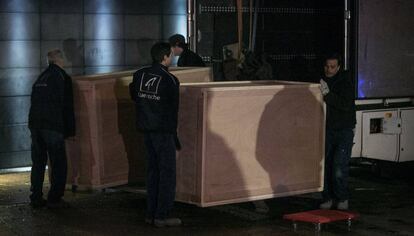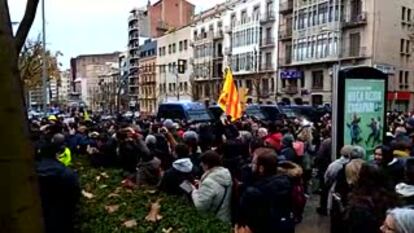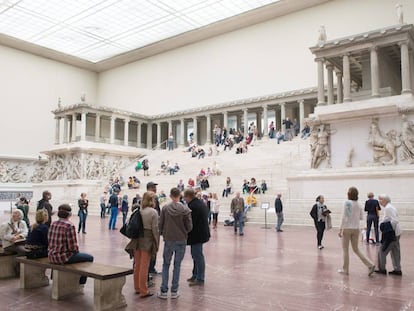Protests as medieval treasures removed from Catalan museum
Transfer of religious objects from Lleida to home region sparks anger among independence supporters


Officers with Catalonia’s regional police force on Monday morning clashed with pro-independence demonstrators who were protesting the transfer of 44 artworks from the region’s Lleida Museum to neighboring Aragon.
The medieval artworks, originally from Aragon’s Monastery of Santa María de Sijena, are being returned to Aragon after a court recently upheld a 2015 ruling that the original sale of the treasures by nuns at the convent to the Catalan government had been illegal. Today, Monday, is the deadline set by the courts for the removal of the artworks in question.
However, the transfer of the heritage-listed artworks, including three polychromatic mortuary chests, comes amid a charged political atmosphere in Catalonia with pro-independence supporters linking the decision to remove the religious treasures with Madrid’s application of emergency powers in the region using Article 155 of the Spanish Constitution – a move that included the sacking of the Catalan government and the calling of a regional election on December 21.
With tensions high, removal of the Sijena artworks began under the cover of darkness. Management at Lleida Museum had expected technicians charged with the transfer to arrive at 8am on Monday. However, regional police cordoned off the area around the museum around midnight, obliging journalists and locals who had gathered outside the cultural center to move on. At around 3.30am. By 4.40am all of the removal crates were ready. The work of cataloguing the items and getting them ready to move was expected to take a further seven to eight hours.
In response to the operation, Lleida’s head of culture affairs, Josep Borrel, on Monday warned that the operation could harm those Aragonese who lived near the Catalan border and accessed health services in El Segrià.
Amb nocturnitat i utilitzant una policia militaritzada, com sempre, tot aprofitant un cop d'estat per espoliar Catalunya amb absoluta impunitat. Aquest és el model de país que defensen Ciudadanos, PSC i PP. https://t.co/z7gUPr6yy2
— Carles Puigdemont (@KRLS) December 11, 2017
“Under the cover of darkness and using militarized police, as always, using a coup d’état by Spain to pillage Catalonia with absolute impunity. This is the type of country defended by Ciudadanos, the Catalan Socialists and the Popular Party.”
“It could end up being the case that people in Aragon ending up losing out because there are services that Catalonia provides to the Aragonese in a generous and disinterested manner, and which they pay for, like health services, which we may end up reconsidering,” said Borrel.
Meanwhile the spokesperson for the pro-independence Republican Left of Catalonia (ERC) in the Spanish Congress spoke of the “humiliation” of the transfer of the artworks, noting it served as a warning over the application of Article 155.
Sacked Catalan premier Carles Puigdemont, currently in Belgium after fleeing Catalonia after the regional parliament’s unilateral declaration of independence, also weighed in, saying on Twitter that Spain had profited from a “coup d’état to pillage Catalonia with impunity.”
A total of 97 artworks from Sijena arrived in Catalonia when nuns from the convent moved to Valldoreix, Barcelona after leaving their former home. The works were then sold to the Catalan government but the Aragon government denounced some of these sales, arguing it had first right of refusal.
English version by George Mills.
Tu suscripción se está usando en otro dispositivo
¿Quieres añadir otro usuario a tu suscripción?
Si continúas leyendo en este dispositivo, no se podrá leer en el otro.
FlechaTu suscripción se está usando en otro dispositivo y solo puedes acceder a EL PAÍS desde un dispositivo a la vez.
Si quieres compartir tu cuenta, cambia tu suscripción a la modalidad Premium, así podrás añadir otro usuario. Cada uno accederá con su propia cuenta de email, lo que os permitirá personalizar vuestra experiencia en EL PAÍS.
¿Tienes una suscripción de empresa? Accede aquí para contratar más cuentas.
En el caso de no saber quién está usando tu cuenta, te recomendamos cambiar tu contraseña aquí.
Si decides continuar compartiendo tu cuenta, este mensaje se mostrará en tu dispositivo y en el de la otra persona que está usando tu cuenta de forma indefinida, afectando a tu experiencia de lectura. Puedes consultar aquí los términos y condiciones de la suscripción digital.
More information
Archived In
Últimas noticias
The complicated life of Francesca Albanese: A rising figure in Italy but barred from every bank by Trump’s sanctions
Pinochet’s victims grapple with José Antonio Kast’s rise in Chile
Reinhard Genzel, Nobel laureate in physics: ‘One-minute videos will never give you the truth’
Half of Scotland is in the hands of 420 property owners
Most viewed
- Pablo Escobar’s hippos: A serious environmental problem, 40 years on
- Reinhard Genzel, Nobel laureate in physics: ‘One-minute videos will never give you the truth’
- Why we lost the habit of sleeping in two segments and how that changed our sense of time
- Charles Dubouloz, mountaineering star, retires at 36 with a farewell tour inspired by Walter Bonatti
- The Florida Keys tourist paradise is besieged by immigration agents: ‘We’ve never seen anything like this’











































